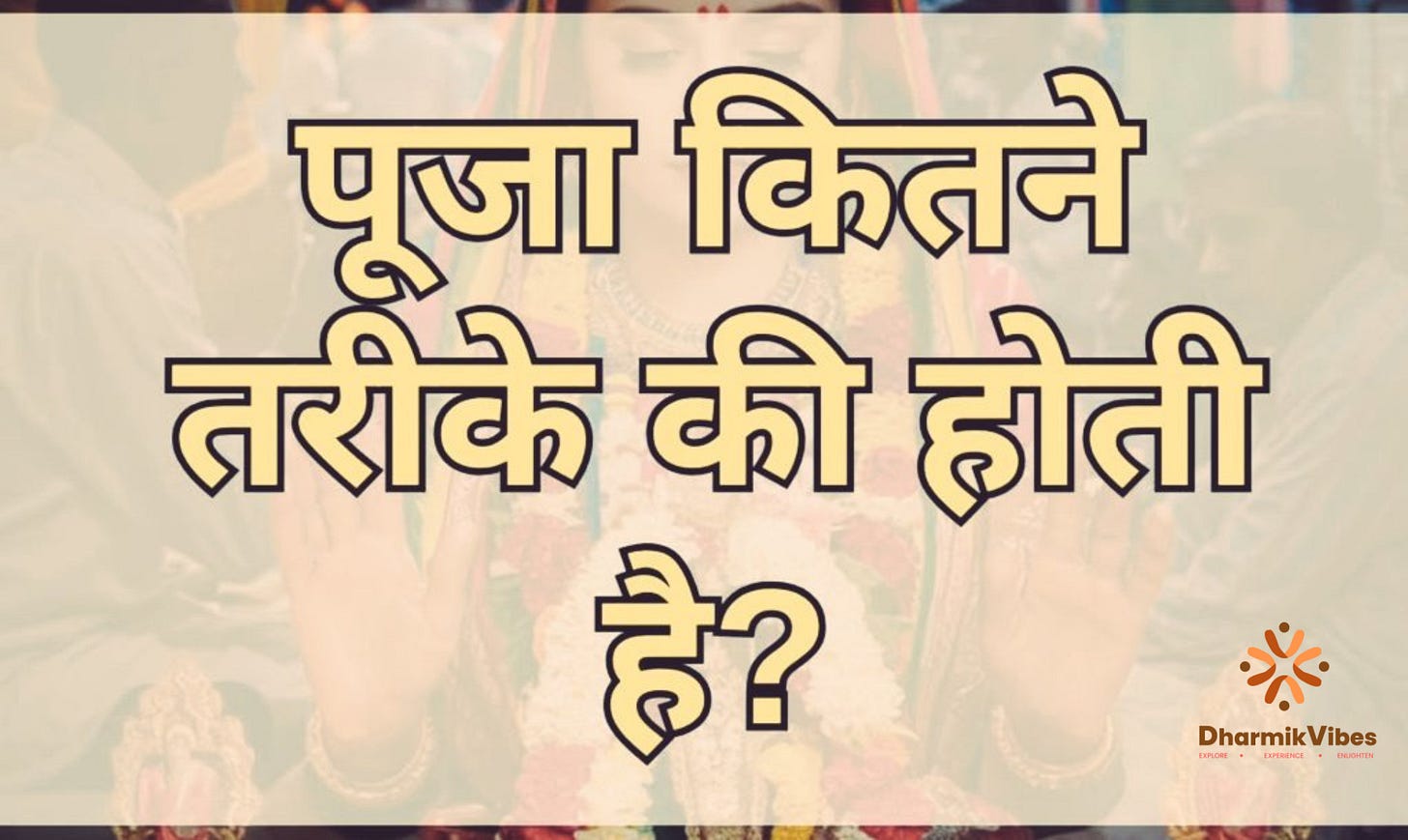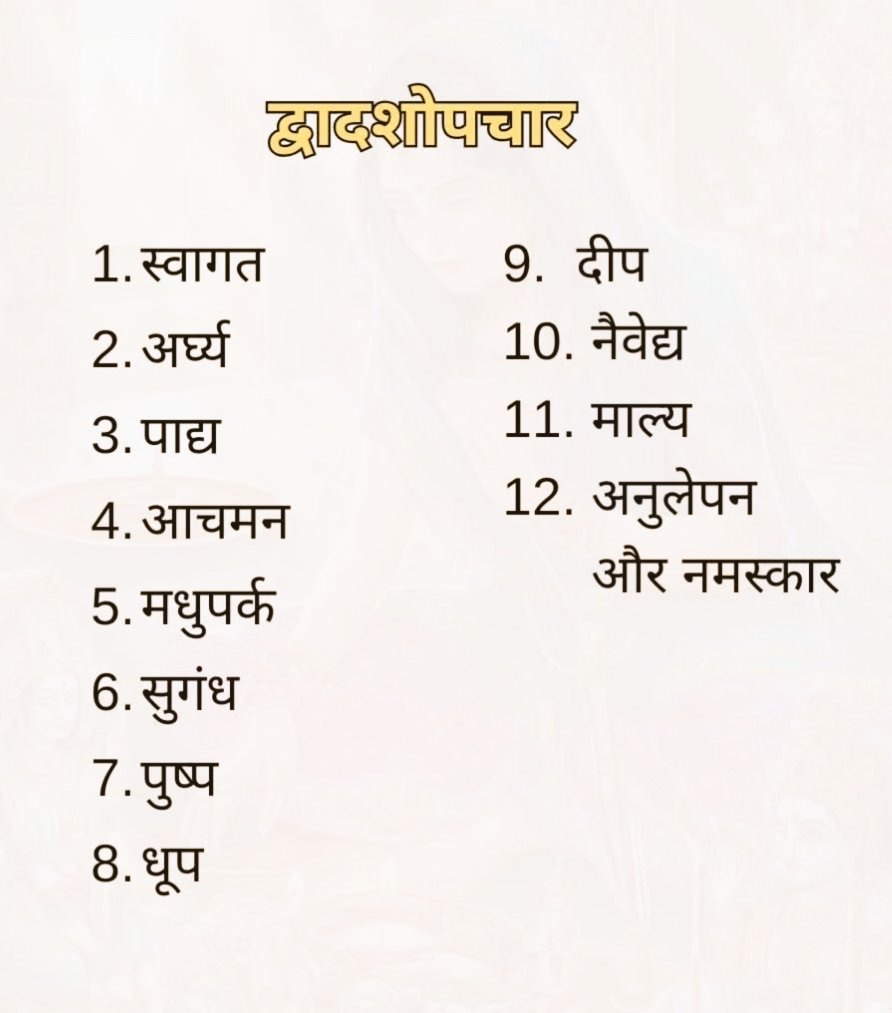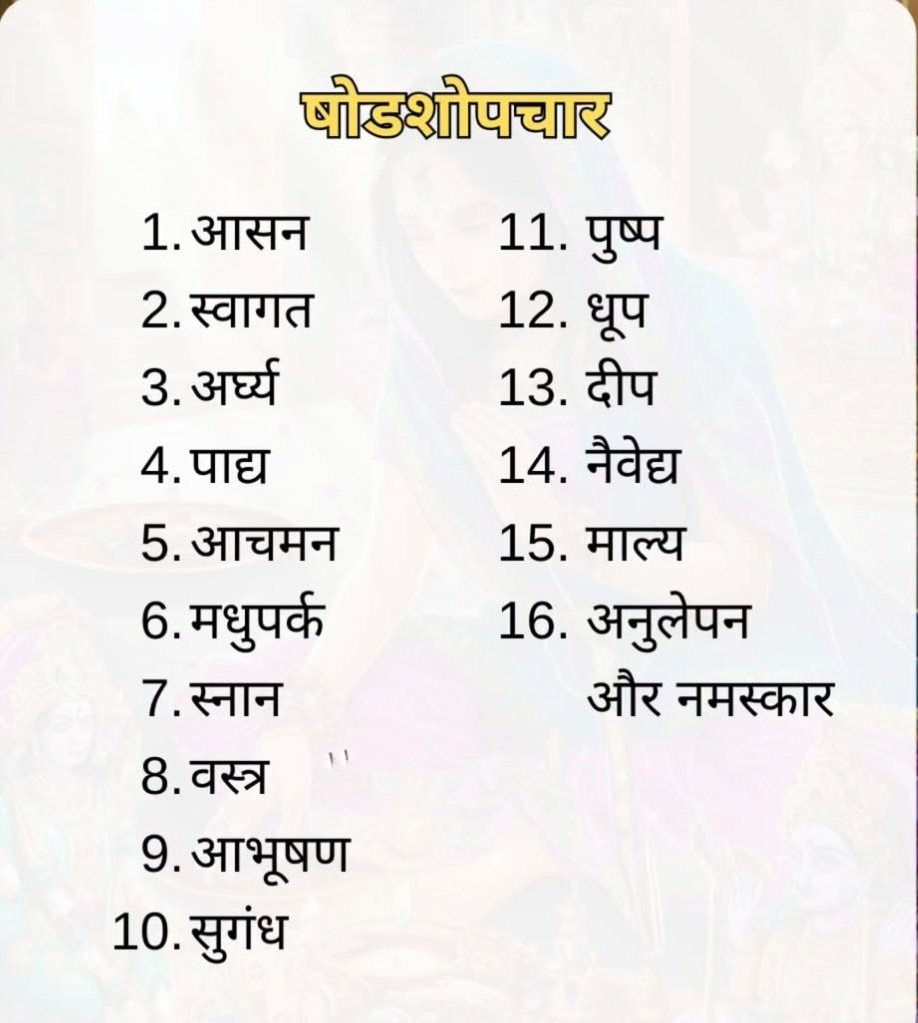In Hinduism, Pooja (worship) is a sacred practice of expressing devotion, reverence, and gratitude to the Divine. Depending on the level of elaboration, occasion, and the deity being worshipped, poojas are classified into four main types:
पंचोपचार (Panchopachar) – 5 उपचार (Offerings)
दशोपचार (Dashopachar) – 10 उपचार (Offerings)
द्वादशोपचार (Dwadashopachar) – 12 उपचार (Offerings)
षोडशोपचार (Shodashopachar) – 16 उपचार (Offerings)
Each step in these poojas represents a symbolic gesture of hospitality towards the deity, treating them as an honored guest. Let us explore each in detail:
🌼 1. Panchopachar Pooja
Literal Meaning: "Five Offerings Worship"
Best Suited For: Daily rituals, home altars, and quick personal devotion.
🔹 Five Offerings:
गंध (Gandha) – चंदन या इत्र अर्पित करना (Applying sandalwood paste or fragrance)
पुष्प (Pushpa) – ताजे फूल अर्पित करना (Offering fresh flowers)
धूप (Dhoop) – अगरबत्ती या धूप जलाना (Lighting incense sticks)
दीप (Deep) – घी या तेल का दीपक जलाना (Lighting an oil lamp or ghee lamp)
नैवेद्य (Naivedya) – फल, मिष्ठान्न या पकवान अर्पण करना (Offering food – fruits, sweets, cooked items)
🌟 Significance:
This is the simplest and most accessible form of pooja, ideal for daily practice by householders. When done with sincerity and devotion, it yields immense spiritual benefits.
🔟 2. Dashopachar Pooja
Literal Meaning: "Ten Offerings Worship"
Best Suited For: Ritualistic worship on festive or special occasions.
🔹 Ten Offerings:
अर्घ्य (Arghya) – पुष्प, चावल और चंदन युक्त पवित्र जल अर्पित करना
(Sacred water offering with flowers, rice, and sandalwood)पाद्य (Padya) – भगवान के चरण धोने हेतु जल अर्पण करना
(Water to wash the deity’s feet)आचमन (Achamana) – शुद्धिकरण हेतु पवित्र जल का सेवन या स्पर्श
(Water for sipping or purification)स्नान (Snana) – जल या पंचामृत से प्रतीकात्मक स्नान कराना
(Symbolic bathing with water or Panchamrit)वस्त्र (Vastra) – वस्त्र अर्पण करना
(Offering of clothes)गंध (Gandha) – चंदन का लेप अर्पित करना
(Applying sandalwood paste)पुष्प (Pushpa) – फूल अर्पित करना
(Offering flowers)धूप (Dhoop) – धूप या अगरबत्ती जलाना
(Offering incense)दीप (Deep) – दीपक जलाना
(Offering a lamp)नैवेद्य (Naivedya) – भोजन, फल या मिष्ठान्न अर्पित करना
(Offering food – fruits, sweets, cooked items)
🌟 Significance:
Dashopachar is more elaborate and ritual-rich. It is suitable for vrats, pujas during festivals, and for more formal worship at temples or home.
📷 Image Reference
🔟➕2️⃣ 3. Dwadashopachar Pooja
Literal Meaning: "Twelve Offerings Worship"
Best Suited For: Weekly vrats (like Monday Shiva pooja), festival poojas, or semi-formal rituals.
🔹 Twelve Offerings:
स्वागत (Swagata) – भगवान का सम्मानपूर्वक स्वागत करना
(Welcoming the deity)अर्घ्य (Arghya) – पवित्र जल अर्पित करना
(Offering holy water)पाद्य (Padya) – चरण धोने हेतु जल अर्पण करना
(Water for the feet)आचमन (Achamana) – शुद्धिकरण हेतु जल का सेवन
(Purification sip)मधुपर्क (Madhuparka) – शहद, दही, घी और दूध का मिश्रण अर्पण करना
(Offering a mixture of honey, curd, ghee, and milk)सुगंध (Sugandha) – इत्र या सुगंधित द्रव्य अर्पण करना
(Fragrant essence or scent)पुष्प (Pushpa) – फूल अर्पित करना
(Flowers)धूप (Dhoop) – धूप या अगरबत्ती जलाना
(Incense)दीप (Deep) – दीपक जलाना
(Lamp)नैवेद्य (Naivedya) – भोजन, फल या मिष्ठान्न अर्पण करना
(Food offering)माला (Mala) – फूलों की माला अर्पित करना
(Garland)अनुलेपन और नमस्कार (Anulepana and Namaskara) – चंदन/हल्दी का लेप लगाना और श्रद्धापूर्वक प्रणाम करना
(Applying sandalwood or turmeric paste and offering salutations)
🌟 Significance:
This pooja promotes mental concentration, spiritual purification, and devotional surrender. It's an ideal balance between daily and grand rituals.
🔟➕6️⃣ 4. Shodashopachar Pooja
Literal Meaning: "Sixteen Offerings Worship"
Best Suited For: Grand rituals, temples, Vedic ceremonies, fasts, festivals, and yajnas.
🔹 Sixteen Offerings:
आसन (Asana) – भगवान के लिए आसन अर्पित करना
(Offering a seat)स्वागत (Swagata) – भगवान का निमंत्रण और स्वागत करना
(Inviting the deity)अर्घ्य (Arghya) – पवित्र जल अर्पण करना
(Holy water)पाद्य (Padya) – चरणों की शुद्धि हेतु जल अर्पण करना
(Foot cleansing)आचमन (Achamana) – पवित्र जल का शुद्धिकरण हेतु अर्पण
(Purification water)मधुपर्क (Madhuparka) – शहद, दही, दूध, घी और चीनी का मिश्रण
(Sacred drink made of honey, curd, ghee, and milk)स्नान (Snana) – जल या पंचामृत से स्नान कराना
(Bath with water or Panchamrit)वस्त्र (Vastra) – वस्त्र अर्पण करना
(Offering clothing)आभूषण (Abharana) – आभूषण या गहने अर्पित करना
(Offering ornaments)सुगंध (Sugandha) – सुगंधित द्रव्य या इत्र अर्पण
(Offering fragrances)पुष्प (Pushpa) – फूल अर्पण करना
(Flowers)धूप (Dhoop) – धूप या अगरबत्ती जलाना
(Incense)दीप (Deep) – दीपक जलाना
(Lamp)नैवेद्य (Naivedya) – फल, मिठाई या भोजन अर्पण करना
(Food offering)माला (Mala) – फूलों की माला अर्पित करना
(Garland)अनुलेपन और नमस्कार (Anulepana and Namaskara) – चंदन/हल्दी का लेप और श्रद्धा से प्रणाम करना
(Paste application and bowing in devotion)
🌟 Significance:
This is the most complete, disciplined, and spiritually potent form of worship. Every aspect of this pooja reflects hospitality, submission, and divine service. It is the standard for temple rituals, Vedic homas, and grand spiritual festivals.
🧾 Comparison
🧾 Comparison of the Four Types of Pooja Rituals:
Panchopachar Pooja involves 5 offerings. It is best suited for daily home worship and is considered the simplest form of pooja.
Dashopachar Pooja involves 10 offerings. This type of pooja is ideal for special events and fasts, and provides a moderate level of ritual detail.
Dwadashopachar Pooja consists of 12 offerings. It is typically performed during weekly rituals and festivals, and is more detailed than the previous two.
Shodashopachar Pooja includes 16 offerings. This is the most comprehensive and is performed during temple rituals, yajnas, and grand spiritual celebrations. It is the most elaborate and complete form of pooja.
The classification of pooja into these four types of "Upacharas" (offerings) reflects the beauty and depth of Sanatan Dharma, which allows worship to be as simple or as detailed as the devotee's intention and capacity allows.
If you're seeking a quick yet meaningful prayer — go for Panchopachar.
For a more ritualistic experience, Dashopachar and Dwadashopachar serve the purpose well.
And if you're looking for a complete, grand, and deeply spiritual pooja, Shodashopachar is the ideal form.





